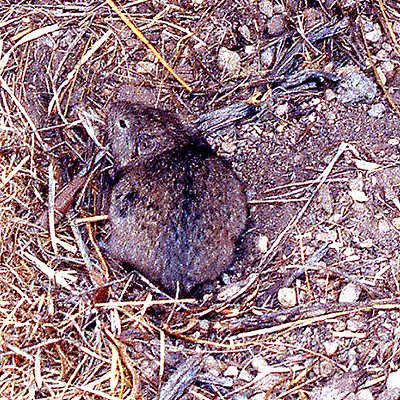Back in the first week of June, my wife Sue and I went over to the Willamette Valley to take part in a delightful day at the Mother Earth News Fair in Albany (taking our son, Caleb, and his family along with us). Among the hundreds of exhibits and talks given by people who knew what they were doing, people trying to sell anything that would make gardening more fun, and genuine workers of the soil, I attended a talk by Matt Borg, a knowledgeable bean farmer from the Albany area.
Matt's talk was on "Gophers, Moles, and Voles" and how to kill them. He wanted them dead, because he found them obnoxious competitors to making a living as a farmer. The best part of his talk about ways to kill those three pestiferous little beasties (to his way of thinking) was trapping; he did not use, or condone the use of poisons.
Before we go any further, please bear with me while I say a little about moles, voles, and gophers. Moles are not rodents, unlike voles and gophers. Moles are insectivores, specialists that eat only invertebrates: worms and insects.
The only mole that we rarely find in this part of Oregon is the coast mole (who got that name because they're found on the coast of BC and Oregon, but also range all the way through our northern counties and into Idaho—go figure common names.) Even with all the real estate they call home, you'll be hard-pressed to even find one in Central Oregon.
On the other hand, voles and gophers are rodents, and rodents eat vegetation—in prodigious amounts! Voles can go through population cycles that are extreme. When we had the last big vole outbreak around 1958, the tiny sagebrush vole, common all around Central Oregon, literally ate the ranchers of Klamath County out of house and home.
Voles can have three or more litters of babies a year, and each batch is made up of up to 15 furry little beasties, and a baby vole will be sexually mature in two months, capable of having more babies, etc. With millions eating grass in one's pasture, one would have to say, "enough is enough," but they can only be "controlled" by Nature herself; disease does them in.
Voles can be so prolific they will leave behind well-worn trails to and fro and are active all year long, so they also leave tunnels under the snow, and they are the preferred food for a foot-long list of raptors and predators.
The beautiful rough-legged hawk that nests in the Arctic Circle and spends winter with us is—without exception—the expert at catching voles. How they do it is one of the great mysteries of nature I shall never solve before I go out among the stars.
Time-and-time-again I have watched with binoculars and a spotting scope, trying to understand how those hawks can hover about 20 feet above the meadow at Sunriver with the wind blowing a gale, snow flying horizontally, and suddenly the hawk will drop into a foot of snow and come up with a vole—not once or twice, but all day long!
For myself, when I'm after a vole, or voles, which are causing damages that I believe can be controlled by trapping them, I use the good old Victor mouse trap that Matt recommends. Set it at right angles to the vole runway. If the voles are prolific, you don't even need to bait the trap with peanut butter.
I usually cover any trap I leave out in the wilds to prevent injuries to raptors and wild predators. For voles, one can set down two pieces of two-by-four about 12 inches long, then place a foot-square piece of one-half inch plywood on the two-by-fours, covering the trap, a rock on the plywood is also a good idea to keep it from wandering away.
And when it comes to gophers, well, what person who works the soil doesn't know how much a gopher can stuff in its fur-lined cheeks and make one's day miserable, not to forget the huge mounds of soil left behind that dull hay-cutting machinery. But then on the other side of the coin, barn owls, great horned owls, red-tailed hawks, Swainson hawks, ferruginous hawks, and weasels think there's nothing in the whole wide world better than a gopher repast.
To help control gophers in the hayfield or kitchen garden, please stay away from the infernal poisons. Sure they're easy to use—drop it in the ground and forget it, the gopher's history—but the risk of secondary poisoning is just too great.
Use a manual trap, like the CINCH Trap; it's cumbersome but if you're careful, it works very well. There are derivatives of that one, and they also work. Matt covers his traps with a plastic gallon plant bucket, and that's very good advice.
It's a shame the good old California #44 wooden gopher trap is no longer available, that one was a winner and never failed, and you didn't need to cover it, it came in its own box. If anyone knows anywhere to purchase them, please let me know: 541-480-3728.
We are probably the only inhabitants of this great old world we live in who can have compassion and be considerate of others who share the space. So, with that in mind, please—before you kill an animal—ask yourself, "Is it really necessary for me to kill this fellow inhabitant for me to survive?"























